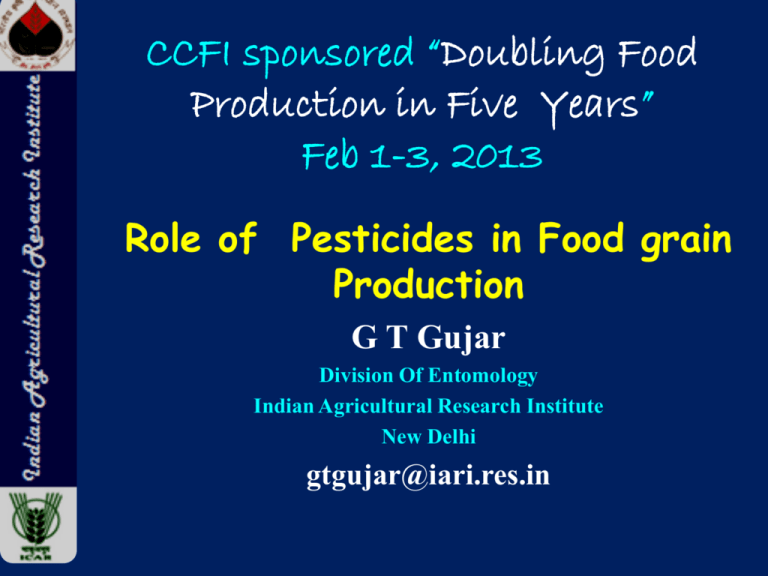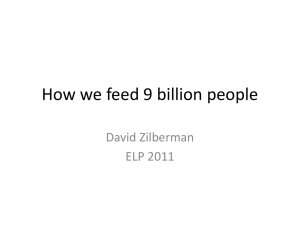GT Gujar6 - Crop Care Federation
advertisement

CCFI sponsored “Doubling Food Production in Five Years” Feb 1-3, 2013 Role of Pesticides in Food grain Production G T Gujar Division Of Entomology Indian Agricultural Research Institute New Delhi gtgujar@iari.res.in “No amount of technologies or external assistance can feed a nation that does not itself prioritize food security and agriculture” and Feeding the world has been possible because of agricultural technology” Norman Borlaug. Estimation of crop losses due to insect pests Crops Yield loss (million tonnes) Monetary value of estimated loss (million rupees) Rice 32.2 240138 Cotton 18.9 339660 Oilseeds 4.2 61000 Pulses 2.6 43551 Rapeseed- mustard 1.5 26100 Wheat 4.1 41368 Sugarcane 87.1 70667 Total Crop losses are estimated at Rs 9,00,000 million (Rs 90,000 Crores) Dhaliwal et al., 2010 Source – Economic Survey – 2009-10 Integrated pest control is a pest management system that, in the context of associated environment and population dynamics of the pest species, utilizes all suitable techniques and methods in as compatible a manner as possible and maintains pest population at level below those causing economic injury (FAO, 1972) Government of India The national agricultural policy (para 24) (1985) has laid special emphasis on IPM: “……Integrated pest management and use of biotic agents in order to minimize the indiscriminate and injudicious use of chemical pesticides, which would be the cardinal principle covering plant protection” Pesticide Use in Different Countries 18 World –Pesticide Production : 2.2 million ton worth $ 43 billion India-4th largest producer 17 Kg/ ha 16 14 12 10 8 6 4 2 0 13 11 9.4 6.6 4.6 4.17 2.5 2.4 2.25 1.3 0.57 0.5 Pesticide Usage and Crop Productivity in different countries Agrochemical Usage Kg/ha Productivity MT/ha 13 7 6 5 3 3 2 0.6 USA China India World Pesticide consumption & Rice or Corn Yield in different countries-2010 PC Kg/ha Rice Yield (T/ha) PC Kg/ha Maize Yield (t/ha) 14 14 12 9.6 7.5 6.5 6.5 5.4 3.5 3.3 3.1 3 3 2 1.3 1.3 0.57 0.57 India China Japan Pakistan USA India China Pakistan USA Consumption of Pesticides in India (1955-2001) Insecticides Usage in Principal crops Crops No. of insecticides registered Groups which belongs Rice (as on 31/11/2012 ) 62 Cotton 79 2 17 6 54 Vegetables 59 3 22 6 28 Wheat 13 0 7 1 5 Soybean 9 0 8 1 0 Total 222 6 78 21 117 OC OP Carbamates Others 1 24 7 30 Source: Compiled from Crop wise directory of CIB Herbicides usage in Principal crops Crops No. of Herbicides registered Groups which belongs Phenoxy Aryloxy phenoxy propinate Chloroacetamide Sulfonyl urea Urea Thiocarbamates others 35 3 3 6 8 0 0 15 Wheat 21 4 5 0 3 2 1 6 Soybean 16 0 5 2 1 0 0 8 Cotton 10 0 2 2 0 1 0 5 Potato 3 1 0 0 0 0 0 2 Total 85 8 15 10 12 3 1 36 Rice Source: Compiled Source: Crop wise directory of CIB Fungicides usage in Principal crops Crops No. of Fungici des register ed Groups which belongs DMI MBI MBC Dithioca rmates Phosphothi olates phenylur eas others Rice 30 7 3 2 4 1 1 12 Potato 21 1 0 1 7 0 0 12 Grapes 35 7 0 3 3 1 0 21 Wheat 13 5 0 3 3 0 0 2 Soybean 3 3 0 0 0 0 0 0 vegetables 23 0 0 3 7 0 0 13 Apple 24 5 0 2 0 0 4 13 149 28 3 14 24 2 5 73 Total DMI – Demethylation Inhibitors; MBI – melatin Biosynthesis Inhibitors; MBC – Methyl benzimidazole carbamates Source: Compiled from Crop wise directory of CIB Pesticide Usage in different States in India (2009-10) Pesticides consumption in tech grade (MT) 10000 9000 Per hectare consumption (gm/ha) 1600 1400 8000 1200 7000 6000 5000 4000 1000 800 600 3000 400 2000 1000 0 200 0 Cost benefit Ratio of pesticide use Crop Avoidable loss % Cost benefit Ratio Cotton 49-90 1:7 Rice 25-51 1:7 Mustard 35-75 1:12 Groundnut 29-42 1:26 Maize 20-25 1:3 Sugarcane 8-23 1:13 Pulses 40-88 1:4 Vegetables 36-60 1:3-14 Fruits 20-35 1:3 Pesticide Use and Cotton Productivity in India Jassid Control and Productivity in Bt cotton Treatments % reduction over control at 10 DAT** Seed cotton yield ( q/ha) Fipronil 5% SC 70.9 (57.50)a 13.5 Spirotetramat 150 OD 42.6 (40.63)de 9.3 Imidacloprid 70% WG 50.0 (45.01) cd 11.1 Buprofezin 25% SC 59.4 (50.51)b 12.2 Spiromesfin 240% SC 46.0 (42.68)de 10.1 Thiacloprid 21.7% SC 37.2 (37.43)g 8.6 53.0 (46.78)c 11.4 - 7.2 Acephate 75% SP Control( untreated) *Figures in parentheses are angular tranformed values, Numbers followed by same superscript are not statistically different. Ramalakshmi et al 2012 Control of mirid bug and productivity in Bt cotton Treatments g or ml/Lit Seed cotton Net yield (q/ha) Returns ( Rs./ha) IBC ratio Acephate 75 WP( 1.0g) 16.18a 41586 19.80:1.00 Fipronil 5 SC( 1.0 ml) 12.11e 30497 13.86:1.00 Nimbecidine 0.03% EC (3.0 ml) 10.95f 27405 12.68:1.00 P..lecanii WP (1×108conidia/ml)(1.0g) 9.68h 24536 15.33:1.00 Profenophos 50 EC (2.0 ml) 14.17b 34899 10.38:1.00 Buprofezin 25 SC(0.5 ml) 12.49d 31223 12.48:1.00 Untreated check 8.17i - Reference: Sugandi & Mallapur (2011) Control of Insect pests and crop yield of Pusa Basmati 1401 during kharif 2010 4000 3500 3000 2500 2000 1500 1000 500 0 3471 3640 3529 3360 Yield (kg/ha) 2781 Control of planthopper and crop yield of Pusa Basmati 1401 during kharif 2011 Control of insect pests and productivity in okra during kharif 2009 Treatment Yield (t/ha) Yield gain Net profit over control (Rs./ha) (t/ha) Econeem - Fipronil - Cartap hydrochloride 3.70 1.34 12960.00 Acetamiprid - Fipronil - Cartap hydrochloride 3.75 1.39 14040.00 Thiamethoxam - Fipronil - Cartap hydrochloride 3.77 1.41 14240.00 Control 2.36 - - * Market price : Okra – Rs. 12/kg; **Cost of input includes cost of labour, insecticides, appliances etc. Rakesh Sharma Pesticide use in Pigeon pea yield and avoidable losses Treatments Total pod damage (%) Avoidable losses (%) Yield (q/ha) Additional Yield (q/ha) Carbosulphan 25 EC 31.1 30.3 15.23 4.64 Acetamiprid 20WP 21.6 30.2 15.20 4.60 Indoxacarb 14.5 SC 34.0 26.7 14.48 3.88 Methomyl 40 SP 38.8 25.3 14.19 3.49 Imidacloprid 17.8 EC 18.3 42.7 18.51 7.91 Dimethoate 25 EC 27.0 37.7 17.01 6.42 Control 63.3 - 10.59 Reference: Mishra et al 2012 Scirtothrips dorsalis management different IPM modules of Capsicum (2009-10) Modules Mean number of thrips/ 5 leaves (Days after spray) % Leaf curl (Days after spray) Module –I 1.0 47.9 Module- II 0.45 25.0 Module-III 1.2 47.9 Module-I : profenophos – abamectin - NSKE 5% - Verticillium lecanii – fenazaquin – profenophos - abamectin & NSKE 5%; Module-II : Imidacloprid - abamectin + dimethoate – acephate – dicofol + imidacloprid – dimethoate + imidacloprid – imidacloprid + abamectin – Dicofol + fenazaquin & abamectin; Module-III : Imidacloprid – Verticillium lecanii – dimethoate + dicofol – dicofol – neem – abamectin – thiamethoxan & Verticillium lecanii. (Nandini et al 2011) Economics of IPM modules in Groundnut during kharif 2009 Treatment Module I (Groundnut+sunflo wer; N.rileyi+NSKE) Module II (Groundnut+ foxtail millet; emamectin) Yield (Rs/ha) (q/ha) Gross Returns (Rs/ha) Groundnut 30.02 Trap / Intercrop 5.0 86,300.00 39.95 4.5 1,07,525.00 17,675.00 89,850.00 1:5.1 - 50000.00 33,490.00 Module III 20.00 (farmer’s practiceonly Quinalphos) Cost of Net profit C:B ratio Cultivation (Rs/ha) (Rs/ha) 16110.00 16,510.00 70,190.00 1:4.3 1:2.0 (Yambhatnel et al., 2011) Combination products for wide range of pest species higher efficacy resistance management • 12 insecticide mixtures for insect control • 17 fungicide mixtures for disease control • 7 herbicide mixtures registered for weed control Insecticide Mixtures for BSFB in Brinjal-- KHARIF 2010 Insecticide Schedules Dose (a.i./ha) Percent Damage (W/W) Triazophos 350 18.84 (25.69) Triazophos 700 14.97 (22.52) Deltamethrin 10 21.35 (27.43) Deltamethrin 20 16.96 (24.25) Mixtures of the above insecticides Triazophos + deltamethrin 360 19.59 (26.24) Triazophos + deltamethrin 720 8.44 (16.76) Control 27.07 (31.33) C.D. (0.05) 5.42 Insect Resistance Management Insecticide Resistance is Ubiquitous More than 500 insect and mite species have evolved resistance Cost of pesticide resistance is estimated at $ 1 billion annually IRM • Cotton bollworms, Jassids, whitefly, planthoppers resistant to conventional insecticides • Diamondback moth resistance • Mohan and Gujar (2003): Crop Protection 22;495 – DBM has shown very high degree of resistance to Fenvalerate (20,000 ppm-3%) – Flufenoxuron (18,000 ppm-28%) – Fipronil (505-fold) – Cartap (24-fold) IRM in cotton Economics of cotton production in the IRM/Farmer Practice. Particulars Pooled ( 2005 & 06) IRM FP Average yield ( q/ha.) 21.0 19.6 % increase in yield over Non-IRM villages 7.01 - No. of sprays 5.0 8.5 % decrease in spray over Non-IRM villages 40.95 - Cost of spray( Rs./ha.) 2552.5 4162.5 Reduced cost over Non-IRM villages(Rs./ha.) 1610 - C:B ratio 1:3.25 1:2.69 Net profit ( Rs./ha.) 28277.5 24032.5 Net profit over Non-IRM villages( Rs./ha.) 4245.0 - Reference : Bajya et al( 2010) Sustainable Crop Productivity in Action Bt Insecticidal toxins-Cry1Ac and Cry2Ab; Cry1C; Cry1F and Vip Herbicide use on herbicide tolerant crops like soybean, cotton, corn and canola Soybean Cotton Transgenics too compliment Pesticide Use and Pest management Trait Area (m ha) 2008 Area (mha) 2010 Herbicide tolerant 79 93.9 Double & triple stacked 26.9 42.2 Insect resistant 19.1 Total 125 Trait $ million in 2007 $ million in 2010 23.9 Herbicides 16,801 17,597 160 m ha Insecticides 9,367 11,042 Fungicides 8,293 10,565 Others 1,722 1,956 Yield Improvement Potential (%) 140% 130% 30% further losses due to drought, heat, cold, salinity 120% 100% 80% 60% 40% 28% prevented losses due to pest, weeds & diseases 42% actual losses due to pests, weeds & diseases 100% 58% 30% 20% 0% Yield without protection Actual yield with crop protection Attainable yield without pests Additional potential without abiotic stress Source: Bayer Cropscience research, Emkay research Use of safe and effective pesticides in judicious manner in conjunction with agronomic practices Pesticide combinations to achieve wide spectrum of activity and economy Pesticide use for Insect Resistance management and as a component of IPM Thanks Thanks to • Organizers –CCFI, New Delhi Director and Jt Director (R), IARI, Dr. Vinay Kalia Dr. Rakesh Sharma Dr. Subhash Chander Dr. Shankarganesh Dr. Sujithra Researchers and Students





